- Home
- Tom Clancy
Battle Ready sic-4
Battle Ready sic-4 Read online
Battle Ready
( Study in Command - 4 )
Tom Clancy
In his first three Commanders books, Tom Clancy teamed with Generals Fred Franks, Jr., Chuck Horner, and Carl Stiner to provide masterful blends of history, biography, you-are-there narrative, insight into the practice of leadership, and plain, old-fashioned storytelling. Battle Ready is all of that-and it is also something more.
Marine General Tony Zinni was known as the "Warrior Diplomat" during his nearly forty years of service. As a soldier, his credentials were impeccable, whether leading troops in Vietnam, commanding hair-raising rescue operations in Somalia, or-as Commander in Chief of CENTCOM-directing strikes against Iraq and Al Qaeda. But it was as a peacemaker that he made just as great a mark-conducting dangerous troubleshooting missions all over Africa, Asia, and Europe; and then serving as Secretary of State Colin Powell's special envoy to the Middle East, before disagreements over the 2003 Iraq War and its probable aftermath caused him to resign.
Battle Ready follows the evolution of both General Zinni and the Marine Corps, from the cauldron of Vietnam through the operational revolution of the seventies and eighties, to the new realities of the post-Cold War, post-9/11 military-a military with a radically different job and radically different tools for accomplishing it. It is an eye-opening book-a front-row seat to a man, an institution, and a way of both war and peace that together make this an instant classic of military history.
Tom Clancy
Battle Ready
“We must salute Clancy for profiling Zinni… You come away thinking that you would have trusted your kid to Zinni’s command… Down at the Army’s infantry school at Fort Benning, the instructors have a saying: ‘Managers do things right, while leaders do the right thing.’ Zinni did the right thing.”
— St. Louis Post-Dispatch
“Fascinating… Clancy supplies lucid contexts for the general’s recollections that are the book’s meat… Zinni’s passion for ‘his’ Marines infuses Battle Ready… Zinni’s achievements and discontents make Battle Ready important… deserves to be widely read because of its timeliness and clarity.”
— Houston Chronicle
“It is Zinni’s twenty-four-page closing statement, ‘The Calling,’ that will sell the book to nonbuff civilians, summing up his service and the ways in which he feels his generation’s legacy is in jeopardy.”
— Publishers Weekly
DEDICATION
TO THE ENLISTED MEN AND WOMEN OF AMERICA’S ARMED FORCES
They are our children.
They are our nation’s greatest treasure.
They are our True Heroes.
They made four decades of service worth every second.
They granted me the greatest honor of my life — the privilege of leading them.
— TONY ZINNI
CHAPTER ONE
DESERT FOX
The Tomahawks were spinning up in their tubes.
It was November 12, 1998. U.S. Marine General Tony Zinni, the commander in chief of United States Central Command (CENTCOM), was standing in his command room overlooking the command center at CENTCOM’s Tampa, Florida, headquarters, leading the preparations for what promised to be the most devastating attack on Iraq since the 1991 Gulf War.
The spacious command center was fitted out with desks, phones, computers, maps, and large and small screens showing updates and the positions of aircraft and ships. In addition to the usual office-type furnishings, the windowed room had secure phones and video communications with Zinni’s superiors and his commanders in the field. It was Zinni’s battle position — the bridge of his ship.
At the end of the First Gulf War, Iraq had agreed to the UN-supervised destruction of its weapons of mass destruction (WMD) and the programs to develop and build them. That agreement had been a lie. The Saddam Hussein regime had never intended to give up its WMD program, and for the next seven years it had conducted a running battle with UNSCOM, the UN inspection operation in Iraq, to protect its programs in any way possible… by hiding them, moving them around, lying, stonewalling, delay, and noncooperation.
The two essential issues covered by the UN mandate were compliance and accountability. That is, the inspectors had to ask and get satisfactory answers to these questions: “Are the Iraqis in compliance with the UN requirement to destroy their WMD and completely dismantle their WMD programs? And are they satisfactorily accounting for the programs and WMD they claim to have destroyed?” The absence of Iraqi cooperation on both of these issues led UNSCOM to make the obvious assumption that the Iraqis were hiding something — either that the weapons still existed or that the Iraqis at least wanted to maintain their capability to make them. UNSCOM had to look hard at the worst case.[1]
When UNSCOM had persisted in carrying out the UN mandate, the Iraqis had raised the stakes — by making it ever harder for UNSCOM to do its job. There had been greater and greater threats and intimidation, lies, obstruction, and hostility… allied with a diplomatic assault aimed at splitting off powerful states friendly to Iraq (principally France, Russia, and China) from the rest of the Security Council and using their support to sabotage the disarmament effort.
With each Iraqi escalation came a counterthreat from the United States: “If UNSCOM is forced to leave Iraq with their work unfinished, the U.S. will hit Iraq and hit it hard.” The threat caught the Iraqis’ attention. As each escalation neared its climax, and the inspectors started to pull out of the country, the Saddam Hussein regime blinked, backed down, and let them return — though each time with fewer teeth.
But now it looked like the Iraqis were not going to blink. The day before, November 11, the UN inspection teams had left once again, apparently for good. As they left, President Clinton had given Zinni the signal to go. The twenty-four-hour launch clock had started.
Zinni knew the moment was approaching for the cruise missile launch — the moment of truth. These weren’t airplanes. Once the Tomahawks were in the air, they could not be recalled.
Before him was an open line to the White House, where the Joint Chiefs of Staff (JCS) vice-chairman, Air Force General Joe Ralston, was sitting. Before him, too, was another line to his Navy component commander, Vice Admiral Willy Moore, in Bahrain. Moore was in constant communications with the eight ships that would launch the initial cruise missile salvo. The clock ticked on.
The twenty-four hours passed. Zinni had told the President that the strike could be stopped at any moment up to six hours before the bombs were scheduled to hit. That was the drop-dead time for a no-go decision. As it happened, he had built in fifteen minutes of fudge time as a safety margin.
But the no-go deadline had passed. And so had Zinni’s fifteen minutes of fudge time.
He took a deep breath — and then the line from the White House lit up: Saddam was backing down again. He’d agreed to UNSCOM’s demands.
General Ralston’s voice came down the wire: “It’s a no-go. Don’t shoot,” he told Zinni. “Do we have any time left? Is it okay?”
Zinni honestly didn’t know. All he could do was grab the phone and call Willy Moore…
For Zinni, this story had begun fifteen months before, on August 13, 1997, when he’d been appointed the sixth CINC (commander in chief) of CENTCOM.[2]
As commander, Zinni watched over a vast region including most of the Middle East, East Africa, and Southwest and Central Asia. His challenges were legion: the delicate, complex relationships with his regional allies; the rising threat of terrorism, led by the not yet world-famous Osama bin Laden; the growing proliferation of weapons of mass destruction; the chronic problems of failed or incapable states, civil wars, border disputes, and criminal activities such as drug trafficking and smuggling; and the difficult task of
containing the two regional hegemons, Iran and Iraq.
Though he would have preferred a balanced approach to all the regional issues rather than having to concentrate his energies and CENTCOM’s capabilities on America’s obsession with Saddam Hussein, by far Zinni’s biggest challenge proved to be enforcing the UN-imposed post-Gulf War sanctions on Saddam’s regime. In his view, Saddam could be contained and marginalized; making him the issue only gave him more clout and distracted the U.S. from more important regional issues, such as the Israeli-Palestinian peace process, Iran, terrorism, and the building of security relationships.
Not long after he became CINC, he proposed a six-point strategic program to William Cohen, President Clinton’s Secretary of Defense, aimed at this more balanced approach. After a polite hearing with Cohen and a session with the Senate Majority and Minority Leaders and the Speaker of the House, Zinni was told to stay out of policy and to stick to execution. “Yes, sir,” he said — always a good Marine.
Meanwhile, the magnitude of the Iraq problem was once again brought home only five days after he took command, at an extended meeting at CENTCOM headquarters with Ambassador Richard Butler, the new head of UNSCOM. CENTCOM provided support for UNSCOM with UN-SUPERVISED U-2 flights over Iraq.
Zinni was already familiar with these missions. Before his appointment as commander, he had, as General Peay’s deputy, coordinated the CENTCOM support missions with Butler’s predecessor, Rolf Ekeus.
On the face of it, UNSCOM’s mandate was straightforward. UN Resolution 687, which set up UNSCOM (and which Iraq had accepted and agreed to support), had directed Iraq to “destroy, remove, or render harmless” its WMD and any missiles with a range greater than 150 kilometers. This process was to have three stages: Iraq would declare its WMD and missiles, UNSCOM would verify the declaration as accurate, and then together UNSCOM and the Iraqis would destroy them.
The Iraqis had given Ekeus a hard time; but his problems were nothing compared with the obstacles they were already putting in the way of his successor. Iraqi efforts to conceal their WMD programs — their “hideous charade,” in Butler’s words — were to have dramatic consequences for Tony Zinni.
Though Tony Zinni did not look like a recruiting poster, he was instantly recognizable as a Marine. He was slightly under medium height, solidly built, barrel-chested, with dark hair cut in the jarhead Marine fashion — very short with shaved back and sides. His look was normally intent, thoughtful, direct, and friendly; laughter came easily to him; and he had the social openness, warmth, and common touch that came from long exposure to all kinds and varieties of people. Hardened by a lifetime of military service — and most especially by Vietnam, which had radically changed him — tough decisions didn’t faze him.
Before becoming the head of UNSCOM, Richard Butler had been the Australian ambassador to the UN, with considerable expertise in arms control and WMD issues. Like Zinni, he came out of a working-class urban Catholic background (Zinni grew up in Philadelphia, Butler in Sydney); and, like Zinni, he was a burly, physically imposing man, friendly, direct, outspoken, and tough.
Not surprisingly, the two men connected easily. Both men listened well and were not reluctant to express their views.
Butler’s first words to Zinni made it clear that he would not play favorites. He’d call the pitches as he saw them. But a successful outcome to the inspections was all up to the Iraqis. If they opened up and came clean with their missiles and WMD, he would give them a clean bill of health, and they’d get their reward — the lifting of the draconian sanctions imposed as a consequence of their invasion of Kuwait in 1990.
So far they had shown zero inclination to come clean — anything but — while crying crocodile tears over their fellow Iraqis, who were enduring the terrible sanctions imposed by the American Satan. (Saddam’s henchmen, meanwhile, lived royally in palaces.)
When it came down to the naked truth, Saddam’s regime was far more interested in keeping their WMD and missile programs than in lifting the sanctions. Yet if they could get the sanctions removed while keeping their WMD, all the better.
Butler had no illusions about the other players in this high-stakes game, either: he was well aware that the Americans had their own agenda — not to mention the UN bureaucracy, the French, the Russians, the Chinese, and everyone else with a stake in what went on inside the nation with the world’s second-largest proven oil reserves… a nation whose government was arguably the most repressive since Stalin’s USSR.
The Iraqis, well aware of these agendas, played everyone off against each other, trying various gambits aimed at ending or at least weakening UNSCOM — from conning Butler, to putting a wedge in the Security Council, to appealing to the Secretary-General for a diplomatic solution (meaning a diplomatic surrender to Iraq). The Iraqis rightly believed that the French, Russians, and Chinese would stand to gain if the sanctions were removed; but their backing had conditions. It had to be covered over by a mask of support for the previous resolutions calling for disarmament. The Iraqis also rightly believed that the Secretary-General and his staff were hopeful of attaining a “diplomatic solution,” even if that meant sacrificing the Security Council’s goal of achieving Iraqi disarmament.
The U.S. agenda was even more subtle and complex. The Americans were increasingly coming to understand that disarmament would never happen with Saddam in power. It was therefore not in their interest for the Iraqis to be seen to comply with UN directives and thus to have the sanctions lifted. In the American view, if Saddam appeared to comply with the inspectors, seemed to meet the conditions set by the UN resolution, and was given a clean bill of health, then he would no doubt restart the WMD programs he had not successfully protected from inspection.
As time passed, the Americans’ goal for Iraq shifted from the WMD-SANCTIONS equation to regime change — a goal they could not openly advocate because of the UN resolutions they had backed. Yet it was clear they had no intention of dropping the sanctions as long as Saddam Hussein’s regime ran Iraq.
The American policy shift did not make Richard Butler’s job any easier. It obviously meant there was no motivation for Saddam to comply with the UN conditions. If the regime and not the WMD was the issue, then there was no reason for them not to keep the WMD programs… Of course, that was an excuse and not a reason. Saddam intended to keep his programs no matter what.
Over the next months, the Iraqis did their best to scam Butler. The scam didn’t work. As they realized he was not a pushover — and was becoming increasingly exasperated by their lies and tricks — they ratcheted up the stakes with attempts at intimidation. By the end of October 1997, they were putting more and more obstacles in the way of the UNSCOM inspectors, and making serious and quite naked threats. At this point, they had two immediate goals: to protect several key sites they had designated “presidential”; and to remove anything “American” from the inspection process, including the U-2 flights. (Of the approximately one thousand UNSCOM inspection staff, about a quarter were American.)
Meanwhile, the Iraqi failure to cooperate had provoked CENTCOM contingency plans for retaliatory air strikes. Though there had been U.S. strikes against the Iraqis before Zinni became CINC, they had been relatively limited. Zinni’s strikes were intended to hurt.
The crisis came to a head in early November, when the Iraqis ordered all the American inspectors to leave Iraq and threatened to shoot down the U-2. Although hitting the high-flying aircraft would have taken a very lucky shot, it was possible.
The question: How to respond to the threat? A U-2 mission was scheduled for November 10. Obviously, an attempt to knock it out would be followed by American bombs. But was the threat alone reason enough to hit Saddam?
That was Zinni’s position. He did not favor flying the mission, preferring instead to strike Iraq immediately (based on the threat), or else to punish them in other ways, such as increasing the airspace in the no-fly zone/no-drive zone enforcement area.[3]
But Washington thought otherwi
se. Their decision was to fly the U-2; and Zinni was ordered to be prepared to conduct immediate air and missile attacks on Iraq if the plane was fired upon. In preparation for the strike, he flew out to the friendly countries in the Gulf to secure agreements to use their airspace, bases, and territorial waters for the strike — a round of visits he would make several times as head of CENTCOM.
On the way, he visited the U-2 pilots at their base in Saudi Arabia. There he learned that the squadron commander had decided to fly the flight himself, an act that impressed Zinni, who later awarded him an air medal for flying into the engagement zones of hostile Iraqi surface-to-air missiles.
Getting agreement from the friendly leaders in the region was not automatic. They were nervous about the strike. Though none had any illusions about the Iraqi leader, they all had a great deal of sympathy for the long-suffering Iraqi people — Arabs, just as they were. A solution that did nothing for the Iraqi people made no sense to them. Thus they all backed an attack that would remove Saddam, but in their minds, yet another round of “pinprick” bombings only made him stronger.
In the end, however, they agreed to a strike if the U-2 was fired upon. Despite their serious questions about the benefits of the U.S. air strikes, they always came through with their support (contrary to U.S. media reports), but preferred to keep the extent of their support private.
The U-2 flew as scheduled on November 10. During the flight, Zinni sat with senior Saudi leaders in the Saudi Ministry of Defense in Riyadh, but in direct communication with CENTCOM’s air operations center, ready to give the order to strike at the first indication that the plane was threatened.
As had often happened before, Saddam’s threat turned out to be hollow. The flight was uneventful.

 Changing of the Guard
Changing of the Guard Clear and Present Danger
Clear and Present Danger Hounds of Rome
Hounds of Rome Breaking Point
Breaking Point Tom Clancy's Jack Ryan Books 7-12
Tom Clancy's Jack Ryan Books 7-12 Full Force and Effect
Full Force and Effect The Archimedes Effect
The Archimedes Effect Combat Ops
Combat Ops Into the Storm: On the Ground in Iraq
Into the Storm: On the Ground in Iraq Under Fire
Under Fire Point of Impact
Point of Impact Red Rabbit
Red Rabbit Rainbow Six
Rainbow Six The Hunt for Red October
The Hunt for Red October The Teeth of the Tiger
The Teeth of the Tiger Conviction (2009)
Conviction (2009) Battle Ready
Battle Ready Patriot Games
Patriot Games The Sum of All Fears
The Sum of All Fears Fallout (2007)
Fallout (2007) Red Storm Rising
Red Storm Rising The Cardinal of the Kremlin
The Cardinal of the Kremlin Executive Orders
Executive Orders Lincoln, the unknown
Lincoln, the unknown Threat Vector
Threat Vector The Hunted
The Hunted Shadow Warriors: Inside the Special Forces
Shadow Warriors: Inside the Special Forces End Game
End Game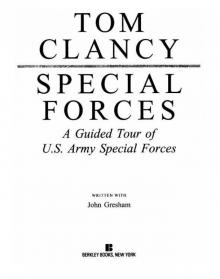 Special Forces: A Guided Tour of U.S. Army Special Forces
Special Forces: A Guided Tour of U.S. Army Special Forces Locked On
Locked On Line of Sight
Line of Sight Tom Clancy Enemy Contact - Mike Maden
Tom Clancy Enemy Contact - Mike Maden Fighter Wing: A Guided Tour of an Air Force Combat Wing
Fighter Wing: A Guided Tour of an Air Force Combat Wing Springboard
Springboard Line of Sight - Mike Maden
Line of Sight - Mike Maden EndWar
EndWar Dead or Alive
Dead or Alive Tom Clancy Support and Defend
Tom Clancy Support and Defend Checkmate
Checkmate Command Authority
Command Authority Carrier: A Guided Tour of an Aircraft Carrier
Carrier: A Guided Tour of an Aircraft Carrier Blacklist Aftermath
Blacklist Aftermath Marine: A Guided Tour of a Marine Expeditionary Unit
Marine: A Guided Tour of a Marine Expeditionary Unit Commander-In-Chief
Commander-In-Chief Armored Cav: A Guided Tour of an Armored Cavalry Regiment
Armored Cav: A Guided Tour of an Armored Cavalry Regiment Tom Clancy's Jack Ryan Books 1-6
Tom Clancy's Jack Ryan Books 1-6 The Ultimate Escape
The Ultimate Escape Airborne: A Guided Tour of an Airborne Task Force
Airborne: A Guided Tour of an Airborne Task Force Debt of Honor
Debt of Honor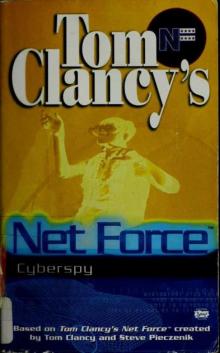 Cyberspy
Cyberspy Point of Contact
Point of Contact Operation Barracuda (2005)
Operation Barracuda (2005) Choke Point
Choke Point Power and Empire
Power and Empire Every Man a Tiger: The Gulf War Air Campaign
Every Man a Tiger: The Gulf War Air Campaign Endgame (1998)
Endgame (1998) EndWar: The Missing
EndWar: The Missing Splinter Cell (2004)
Splinter Cell (2004) The Great Race
The Great Race True Faith and Allegiance
True Faith and Allegiance Deathworld
Deathworld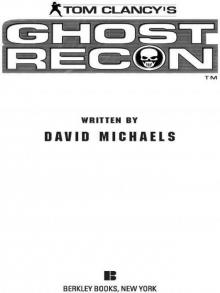 Ghost Recon (2008)
Ghost Recon (2008) Duel Identity
Duel Identity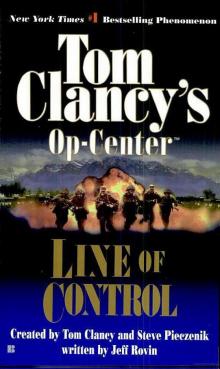 Line of Control o-8
Line of Control o-8 The Hunt for Red October jr-3
The Hunt for Red October jr-3 Hidden Agendas nf-2
Hidden Agendas nf-2 Acts of War oc-4
Acts of War oc-4 Ruthless.Com pp-2
Ruthless.Com pp-2 Night Moves
Night Moves The Hounds of Rome - Mystery of a Fugitive Priest
The Hounds of Rome - Mystery of a Fugitive Priest Into the Storm: On the Ground in Iraq sic-1
Into the Storm: On the Ground in Iraq sic-1 Threat Vector jrj-4
Threat Vector jrj-4 Combat Ops gr-2
Combat Ops gr-2 Virtual Vandals nfe-1
Virtual Vandals nfe-1 Runaways nfe-16
Runaways nfe-16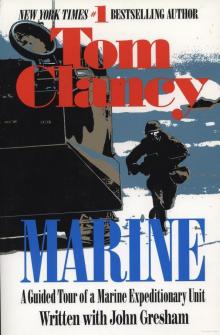 Marine: A Guided Tour of a Marine Expeditionary Unit tcml-4
Marine: A Guided Tour of a Marine Expeditionary Unit tcml-4 Shadow Warriors: Inside the Special Forces sic-3
Shadow Warriors: Inside the Special Forces sic-3 Jack Ryan Books 1-6
Jack Ryan Books 1-6 Cold Case nfe-15
Cold Case nfe-15 Changing of the Guard nf-8
Changing of the Guard nf-8 Splinter Cell sc-1
Splinter Cell sc-1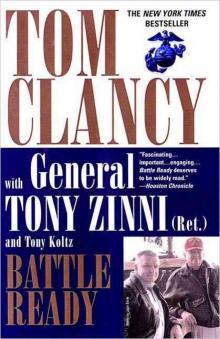 Battle Ready sic-4
Battle Ready sic-4 The Bear and the Dragon jrao-11
The Bear and the Dragon jrao-11 Fighter Wing: A Guided Tour of an Air Force Combat Wing tcml-3
Fighter Wing: A Guided Tour of an Air Force Combat Wing tcml-3 Patriot Games jr-1
Patriot Games jr-1 Jack Ryan Books 7-12
Jack Ryan Books 7-12 Mission of Honor o-9
Mission of Honor o-9 Private Lives nfe-9
Private Lives nfe-9 Operation Barracuda sc-2
Operation Barracuda sc-2 Cold War pp-5
Cold War pp-5 Point of Impact nf-5
Point of Impact nf-5 Red Rabbit jr-9
Red Rabbit jr-9 The Deadliest Game nfe-2
The Deadliest Game nfe-2 Springboard nf-9
Springboard nf-9 Safe House nfe-10
Safe House nfe-10 EndWar e-1
EndWar e-1 Duel Identity nfe-12
Duel Identity nfe-12 Deathworld nfe-13
Deathworld nfe-13 Politika pp-1
Politika pp-1 Rainbow Six jr-9
Rainbow Six jr-9 Tom Clancy's Power Plays 1 - 4
Tom Clancy's Power Plays 1 - 4 Endgame sc-6
Endgame sc-6 Executive Orders jr-7
Executive Orders jr-7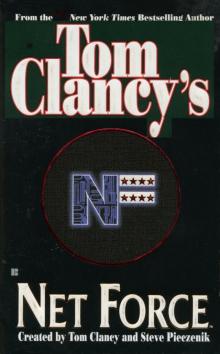 Net Force nf-1
Net Force nf-1 Call to Treason o-11
Call to Treason o-11 Locked On jrj-3
Locked On jrj-3 Against All Enemies
Against All Enemies The Sum of All Fears jr-7
The Sum of All Fears jr-7 Sea of Fire o-10
Sea of Fire o-10 Fallout sc-4
Fallout sc-4 Balance of Power o-5
Balance of Power o-5 Shadow Watch pp-3
Shadow Watch pp-3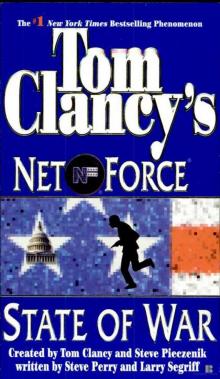 State of War nf-7
State of War nf-7 Wild Card pp-8
Wild Card pp-8 Games of State o-3
Games of State o-3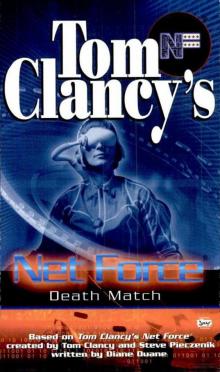 Death Match nfe-18
Death Match nfe-18 Against All Enemies mm-1
Against All Enemies mm-1 Every Man a Tiger: The Gulf War Air Campaign sic-2
Every Man a Tiger: The Gulf War Air Campaign sic-2 Cybernation nf-6
Cybernation nf-6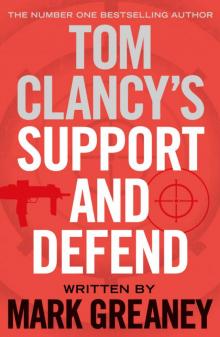 Support and Defend
Support and Defend Night Moves nf-3
Night Moves nf-3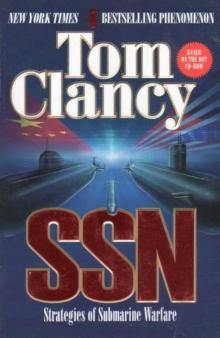 SSN
SSN Cutting Edge pp-6
Cutting Edge pp-6 The Cardinal of the Kremlin jrao-5
The Cardinal of the Kremlin jrao-5 War of Eagles o-12
War of Eagles o-12 Op-Center o-1
Op-Center o-1 Mirror Image o-2
Mirror Image o-2 The Archimedes Effect nf-10
The Archimedes Effect nf-10 Teeth of the Tiger jrj-1
Teeth of the Tiger jrj-1 Bio-Strike pp-4
Bio-Strike pp-4 State of Siege o-6
State of Siege o-6 Debt of Honor jr-6
Debt of Honor jr-6 Zero Hour pp-7
Zero Hour pp-7 Ghost Recon gr-1
Ghost Recon gr-1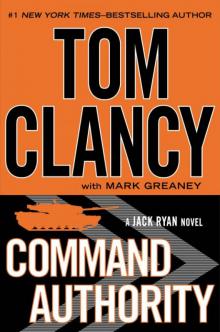 Command Authority jr-10
Command Authority jr-10 Tom Clancy's Power Plays 5 - 8
Tom Clancy's Power Plays 5 - 8 Checkmate sc-3
Checkmate sc-3 Breaking Point nf-4
Breaking Point nf-4 Gameprey nfe-11
Gameprey nfe-11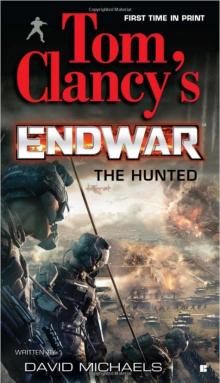 The Hunted e-2
The Hunted e-2 Hidden Agendas
Hidden Agendas Divide and Conquer o-7
Divide and Conquer o-7